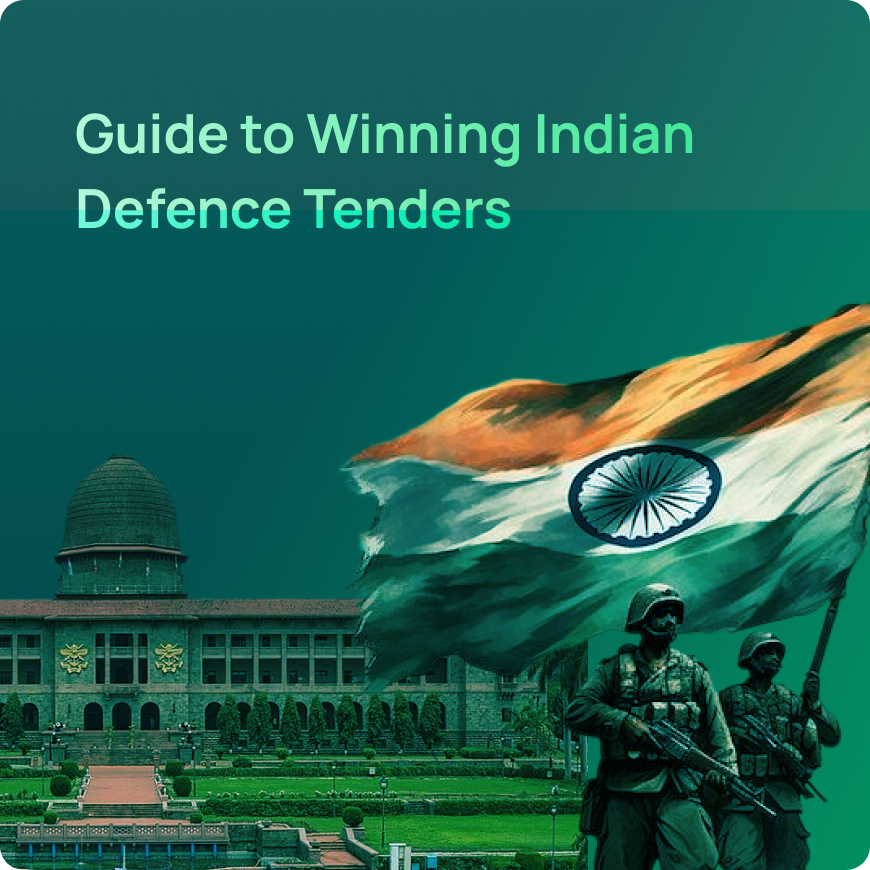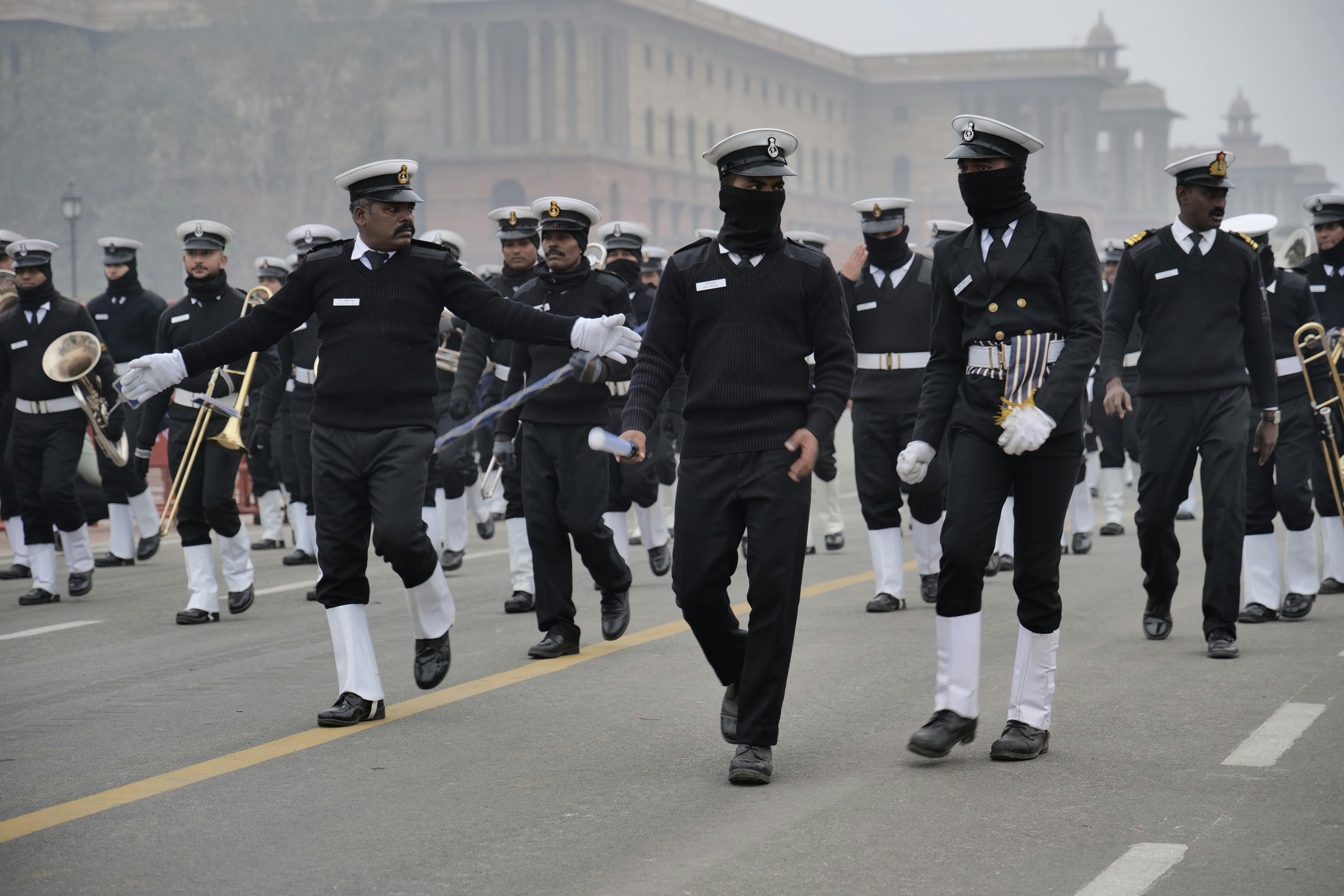Your Comprehensive Guide to Winning Defence Tenders in India (2025)
Unlock India's defence sector potential. Learn how to find Ministry of Defence tenders, register on the eProcurement portal, leverage GeM and DPSU platforms, and use AI to stay ahead

Your Comprehensive Guide to Winning Defence Tenders in India (2025)
Introduction: India’s defence sector is booming. Record budgets (rising from ₹2.53 lakh crore in 2013–14 to ₹6.21 lakh crore in 2024–25 and initiatives like Make in India and Atmanirbhar Bharat are driving a surge in procurement and domestic production. For CXOs and bid professionals, this means more lucrative defence tenders and an urgent need to master the process. Our guide lays out a clear, step-by-step strategy: from registering on the Ministry of Defence’s eProcurement portal to tracking Ministry of Defence tenders and exploring DPSU opportunities. We also show how AI in tender analysis can sharpen your go/no-go decisions and automate tender synopses. By the end, you’ll know exactly how to unlock these contracts, in line with India’s vision of self-reliance in defence.
Understanding the Landscape: Who Floats Defence Tenders in India?
India’s defence contracts come from several sources. At the top is the Ministry of Defence (MoD), which oversees procurement for the Army, Navy, Air Force and associated organisations. The MoD runs a central eProcurement portal (defproc.gov.in) to publish tenders and facilitates electronic submission. Under this umbrella, each branch of the Indian Armed Forces (Army, Navy, Air Force, and Military Engineer Services) may issue its own contracts. These can range from major weapons systems to base construction or maintenance projects.
Parallel to the services, India’s Defence Public Sector Undertakings (DPSUs) (such as Hindustan Aeronautics Ltd, Bharat Electronics Ltd, Bharat Earth Movers Ltd, Bharat Dynamics Ltd, etc.) are state-owned companies that design and manufacture military equipment. DPSUs often float defence tenders for subsystems, spares and related services. For example, Bharat Heavy Electricals Limited (BHEL) – a major DPSU – hosts its own Government eProcurement portal for bids. (Visit BHEL eProcurement to register.) Each DPSU typically has a tendering wing that publishes RFPs or RFQs on either the MoD portal or its own site.
Another key player is the Department of Defence Production (DDP), the MoD department tasked with promoting domestic manufacturing. DDP supports Make in India efforts and may issue contracts for infrastructure or R&D projects. The DDP has set up public sector production facilities through DPSUs and licensed the private sector, aiming for self-reliance. It may publish Requests for Information (RFIs) or RFPs for technology development initiatives or defence testing infrastructure.
Finally, the Defence Research and Development Organisation (DRDO) – India’s premier defence R&D agency – issues tenders for research projects, laboratory equipment and prototype development. DRDO’s procurement often happens via government portals CPPP and GeM, and it also invites industry participation (e.g. through the iDEX innovation portal). In summary, if you’re pursuing defence business, you must watch for opportunities from the MoD and its Services, DPSUs like BHEL/BEL/HAL, the DDP, and DRDO – all of whom float Department of Defence tenders and contracts as part of India’s defence buildup.

Your Gateway to Opportunity: Key Platforms for Defence Tenders eProcurement
India’s tender notices are mostly published online. The primary eProcurement portals for defence include:
Central Public Procurement Portal (CPPP): This is the Government of India’s unified portal (eprocure.gov.in) where all central ministries – including Defence – publish tenders. The CPPP (also called the ePublishing System) “facilitates all the Central Government Organisations to publish their Tender Enquiries, Corrigenda and Award of Contract details”. Defence contracts (Air Force, Army, DRDO, DPSUs, etc.) appear here alongside others. The portal allows advanced search by organization, location or classification. Bid documents are downloadable free, and submission is online through the portal. Agencies like DRDO explicitly direct vendors to use the CPPP for formal RFPs.
Government e-Marketplace (GeM): GeM (gem.gov.in) is the official online marketplace for government procurement of goods and services. While GeM handles mostly “off-the-shelf” items, many defence tenders (e.g. vehicles, uniforms, IT hardware) are now published there as GeM tenders. Agencies like the MoD and DRDO have joined GeM to improve efficiency. (For example, DRDO’s site links to GeM for vendor registration.) GeM offers e-bidding, reverse auctions and instant PO tools, with GeM T&C and dynamic discounts tailored to government buyers.
Dedicated DPSU and Armed Forces Portals: Some Defence organisations have their own procurement sites. For example, BHEL operates its own tender site (eprocurebhel.co.in) for projects in power and defence. (From the homepage: “The eProcurement System enables the Tenderers to download the Tender Schedule free of cost and then submit the bids online through this portal.”) Other DPSUs (like HAL, BEL, etc.) and Armed Forces logistics wings may also publish opportunities on separate portals or intranet e-procurement systems. For instance, the Military Engineer Services (MES, under the Army) and some Cantonment Boards list tenders on the MoD portal, while entities like Indian Ordnance Factories have their e-tender sites. In practice, first check the MoD’s defproc portal and CPPP; then supplement this by visiting DPSU websites (many link to their e-proc sites) and the e-procurement defence portal of the specific service or unit.
In all cases, these portals require vendors to register a user account. Once logged in, you can browse current defence force tenders by keyword or category, set up email alerts, and track deadlines.

The Step-by-Step Process to Winning a Ministry of Defence Tender
Winning a Ministry of Defence tender requires meticulous preparation. Here’s a typical workflow:
Eligibility and Registration: Before anything, ensure you meet the tender’s eligibility criteria (e.g. company type, past experience, financial standing). Register online on the relevant eProc portal(s) – for MoD tenders, register on defproc.gov.in and CPPP; for GeM tenders, register on gem.gov.in. You will need a valid Class-III Digital Signature Certificate (DSC) from an authorized certifying authority. In practice, have your DSC token and portal login set up well before bid time.
Tender Discovery and Tracking: Use the portals’ search functions (by organisation name, location, keywords like “defence procurement”) or RSS/email notifications to find relevant tenders. Bookmark or flag promising tenders. Note that tenders may be amended or extended – always review the “Corrigendum” section for updates.
Understanding the Tender Document (RFP/RFI): Once you find a tender, download the full RFP (Request for Proposal) or RFI (Request for Information). Read it carefully – it will include scope of work, eligibility (Pre-Qual) criteria, technical specifications, bid submission instructions, deadlines and evaluation methodology. Pay close attention to Scope, Technical Specifications, Delivery schedule, Warranty or offset obligations, and Evaluation criteria. According to official guidance, bidders should “go through the notice inviting tender/advertisement, tender & its related documents carefully to understand the requirements”. Often the tender will specify what supporting documents to submit (e.g. financial statements, ISO certifications, past project references).
The Pre-Bid Meeting: Many defence tenders schedule a pre-bid conference or Q&A session. This is your chance to clarify doubts about the RFP. Prepare questions and attend (physically or via video link). Any answers or additional information given may be recorded as formal corrigenda. Even if attendance is optional, it’s highly recommended to identify ambiguities and refine your bid accordingly. (In any case, if you have technical questions, contact the tender authority in writing before the pre-bid deadline.)
Bid Preparation – Technical and Financial Bids: Defence tenders are usually two-part bids. The Technical Bid should demonstrate your capability: team qualifications, past experience, compliance statements, drawings or test results if needed. Follow the RFP’s prescribed format and provide exactly the documents requested. The Financial Bid (or Price Bid) is usually sealed separately: it includes your cost quotation, taxes, and details of pricing. Ensure you include bid security (earnest money deposit) if required. Many tenders use a specified bid format (e.g. BOQ spreadsheets); fill them out exactly. The RFP will state if evaluation uses L1 (lowest price among technically qualified bidders) or other methods. Double-check all figures and compliance points – a small mistake could disqualify you.
Online Submission: Upload your completed bid before the deadline on the portal. The CPPP/defence portal will display the server time and cutoff. (According to the NIC eProc guidelines, “the server time (displayed on the bidder’s dashboard) shall be considered as the standard time for referencing the deadlines”.) Allow extra time in case of internet issues. Remember to encrypt and sign your bid submission with your DSC as instructed. It’s wise to submit a day early if possible, or at least well before the deadline. After submission, keep screenshots or printouts of the confirmation page.
Bid Opening and Evaluation: On the opening date/time, the MoD tender committee will open technical bids (in the case of two-stage evaluation). Technical bids are screened first; only those meeting all the technical requirements move to the financial stage. If it’s a single-stage (combined), both parts may be opened together. Once the technical evaluation is done, qualified bidders’ financial bids will be opened. The final selection is made as per the RFP rules (often the lowest price among technical qualifiers). Any clarifications sought by the committee must be answered promptly by the bidder.
Award of Contract: If your bid is selected, you will receive a Letter of Intent (LoI) or Letter of Award (LoA). You may need to submit a performance bank guarantee and sign a contract. Ensure you deliver on the agreed schedule and quality to maintain your reputation. The contract terms (payment schedule, liquidated damages, warranty, etc.) will have been in the RFP; be prepared to adhere strictly to them.
By following these steps carefully and maintaining clear records of compliance, you can increase your chances of success. Remember: the Ministry’s eProcurement portal (Defence) and CPPP simplify the submission but don’t replace the hard work of thorough bid preparation.

Advanced Strategies for Defence Tender Success
Successfully winning defence tenders requires more than just following the basic process. Here are advanced strategies that can set you apart:
Understanding Defence Procurement Categories
Defence procurement in India typically falls into these categories:
- Capital Acquisition: Major weapon systems, platforms, and equipment
- Revenue Procurement: Consumables, spares, and services
- R&D Procurement: Research projects and prototype development
- Infrastructure Projects: Construction and facility development
Each category has different evaluation criteria, compliance requirements, and timelines.
Leveraging AI for Competitive Advantage
Modern tender analysis increasingly relies on AI tools to:
- Automated Tender Monitoring: Set up AI-powered alerts for relevant opportunities
- Risk Assessment: Use machine learning to identify potential bid risks
- Competitive Intelligence: Analyze past awards and competitor strategies
- Document Processing: Automate compliance checking and bid preparation
Building Strategic Partnerships
Defence tenders often require consortium approaches:
- Technology Partners: For technical expertise and innovation
- Local Partners: For regional presence and market knowledge
- Financial Partners: For large-scale project financing
- Supply Chain Partners: For manufacturing and logistics support
Common Pitfalls and How to Avoid Them
Learning from common mistakes can significantly improve your success rate:
Technical Compliance Issues
- Incomplete Documentation: Always submit all required certificates and documents
- Specification Deviations: Clearly mark any deviations and provide justifications
- Quality Standards: Ensure all products/services meet specified Indian or international standards
Financial Proposal Errors
- Pricing Mistakes: Double-check all calculations and currency conversions
- Tax Implications: Factor in all applicable taxes and duties
- Payment Terms: Understand and comply with government payment cycles
Timeline Management
- Submission Deadlines: Submit well before the deadline to avoid technical issues
- Delivery Schedules: Be realistic about delivery timelines and factor in approvals
- Milestone Planning: Break down large projects into manageable milestones
Future Trends in Indian Defence Procurement
Stay ahead by understanding emerging trends:
Digital Transformation
- Blockchain: For supply chain transparency and contract management
- IoT Integration: For equipment monitoring and predictive maintenance
- Cloud Solutions: For secure data management and collaboration
Sustainability Focus
- Green Technology: Increasing preference for environmentally friendly solutions
- Circular Economy: Emphasis on recycling and sustainable manufacturing
- Carbon Footprint: Requirements for low-impact logistics and operations
Indigenous Manufacturing
- Make in India 2.0: Enhanced focus on domestic production capabilities
- Technology Transfer: Requirements for local technology development
- Skill Development: Investment in local workforce training and development
Conclusion
The Indian defence sector presents unprecedented opportunities for businesses ready to navigate its complexities. Success requires a combination of technical expertise, regulatory compliance, strategic partnerships, and continuous learning. By following the structured approach outlined in this guide and staying informed about emerging trends, you can position your organization to capitalize on India’s defence modernization journey.
Remember that winning defence tenders is not just about the lowest price – it’s about demonstrating capability, reliability, and commitment to India’s security objectives. Invest in understanding the sector, building relationships, and developing solutions that truly meet the nation’s defence needs.
The path to success in Indian defence tenders is challenging but rewarding. With the right approach, preparation, and persistence, your organization can become a valued partner in India’s journey towards defence self-reliance.